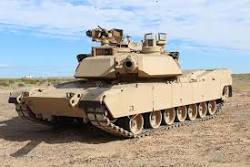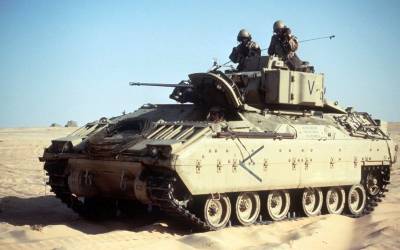April 24, 2024
Flexible G/ATORs: The USMC's Multi-Mission AESA Ground Radars
G/ATOR diorama (click to view full) The US military’s long run of unquestioned air superiority has led to shortcuts in mobile land-based air defenses, and the US Marines are no exception. A December 2005 release from Sen. Schumer’s office [D-NY] said that: “Current radar performance does not meet operational forces requirements… consequences could potentially allow […]
Full Article Status: paid
April 15, 2024
Digital Abrams: The M1A2 SEP Program
M1A2 SEP (click to view full) America’s M1 Abrams tanks come in a number of versions. In addition to the M1A1 that is now standard, the US Army is beginning to field its M1 TUSK for urban warfare. It also operates the M1A2 System Enhancement Program (SEP), currently the most advanced standard variant. This Spotlight […]
Full Article Status: free
February 6, 2024
The US Army's Bradley Remanufacture Program
M3A3 Bradley CFV: Charge! (click to view full) In the 1970s, middle eastern wars demonstrated that tanks without infantry screens were vulnerable to infantry with anti-tank missiles. Unfortunately, armored personnel carriers were easy prey for enemy tanks, and sometimes had trouble just keeping up with friendly tanks like America’s 60+ ton, 50+ mph M1 Abrams. […]
Full Article Status: sample
November 24, 2023
The Fighter Still Remains... The Boxer MRAV APC Family
Boxer MRAV (click to view full) Wheeled armored vehicles have become much more common, but the Dutch-German Boxer stands out from the crowd. Its English acronym is “Multi Role Armoured Vehicle” (MRAV), but rather than being a family of different vehicles, the Boxer will use a single chassis, with snap-in modules for different purposes from […]
Full Article Status: free
May 17, 2023
Digital Abrams: The M1A2 SEP Program
M1A2 SEP (click to view full) America’s M1 Abrams tanks come in a number of versions. In addition to the M1A1 that is now standard, the US Army is beginning to field its M1 TUSK for urban warfare. It also operates the M1A2 System Enhancement Program (SEP), currently the most advanced standard variant. This Spotlight […]
Full Article Status: free
June 8, 2021
US Army Moves Ahead with V-Hull Strykers
M1126, post-IED (click to view full) Under current plans, the 8×8 wheeled Stryker armored vehicle will be the future backbone of 8 US Army and 1 National Guard medium armored brigades. The 5th Stryker Brigade from Fort Lewis, WA was the first Stryker unit sent to Afghanistan, deployed in the summer of 2009 as part […]
Full Article Status: free
May 26, 2021
Have Guns, Will Upgrade: The M109A7 Paladin PIM Self-Propelled Howitzer
Before: M109 & M992 (click to view full) The USA’s 155mm M109 self-propelled howitzers (SPH) were first introduced in 1962, as a form of armored mobile artillery that could stand up to the massed fire tactics of Soviet heavy artillery and rockets. They and their companion M992 Armored Ammunition Resupply Vehicles (AARV) have been rebuilt […]
Full Article Status: free
May 5, 2021
US Military Adds Heavy Trucks Under FHTV-III
Latest updates: Battle for Oshkosh: Will FHTV re-bid copy FMTV mistake? THAAD on HEMTT (click to view full) In 2009, with its bridge buy of FMTV medium trucks in place, and initial awards for the potential JLTV Hummer replacement designs underway, the next order of business on the US Army’s agenda was a new Family […]
Full Article Status: free
July 10, 2020
Days of the Jackal: Supacat's HMT Vehicles
MWMIK Jackal (click to view full) Britain is part of the general push by western countries to field heavier, mine-protected vehicles, via orders for the Mastiff Cougar variant and its smaller 4×4 Ridgback companion. UK forces are also fielding vehicles like the Land Rover WMIK (Weapons Mounted Installation Kit) that have a very different core […]
Full Article Status: free
May 21, 2020
Soldier Battle JTRS: The HMS Radio Set + SANR
PRC-154 with 75th RR (click to view full) The Pentagon’s JTRS (Joint Tactical Radio System) aimed to replace existing radios in the American military with a single set of software-define radios that could have new frequencies and modes (“waveforms”) added via upload, instead of requiring multiple radio types in ground vehicles, and using circuit board […]
Full Article Status: free
May 4, 2020
TPQ-53 Counterfire Radars: Incoming... Where?
EQ-36 concept (click to view full) Firefinder radars track the path of incoming shells, rockets, mortars, etc., and calculate the point they were fired from. Raytheon’s TPQ-36 radar is specifically designed to counter medium range enemy weapon systems out to a range of 24 kilometers, while the TPQ-37 can locate longer-range systems, and even surface […]
Full Article Status: free
February 6, 2020
Land Panther: Germany's Tracked Puma IFV
Drivers wanted… (click to view full) Germany has always been known for producing excellent armored vehicles. A combination of features that arguably make it the world’s best tank, and fire sale prices stemming from Germany’s rapid disarmament, have made the Leopard 2 the standard main battle tank in Europe and beyond. The same level of […]
Full Article Status: paid
November 12, 2019
WCSP: Mid-Life Upgrade for Britain's Warrior IFVs
Warrior in “Wrap-2” (click to view full) Britain’s MCV-80/FV510 Warrior Infantry Fighting Vehicle was produced between 1984 and 1995. Built of all-welded aluminum construction and armed with the 30 mm Rarden cannon, it was designed to destroy enemy armored personnel carriers at ranges of up to 1,500m, while offering a fast, armored battlefield taxi for […]
Full Article Status: free
September 25, 2019
France Finally Kickstarts Scorpion Land Vehicle Acquisition
Griffon In 2009 France was planning to start delivering by 2015 new multirole armored vehicles to replace a variety of aging infantry vehicles starting, within a large modernization program called Scorpion. But the 2010-14 multiyear budget relied on a number of rosy assumptions that were soon disproved by reality, and the Scorpion program was one […]
Full Article Status: free
July 3, 2019
Digital Raven: Hand-Launched UAV Goes Binary
Latest updates: USAF to use RQ-11Bs at bases worldwide. RQ-11B Raven (click to view full) The RQ-11 Raven is a 4.2-pound, backpackable, hand-launched UAV that provides day and night, real-time video imagery for “over the hill” and “around the corner” reconnaissance, surveillance and target acquisition. Each Raven system typically consists of 3 aircraft, 2 ground […]
Full Article Status: free
February 28, 2019
Double-Jointed & Popular: The Bv Family of Infantry Support Vehicles
A Viking comes ashore The BvS10 is the successor to the wildly popular Bv206, 11,000 of which have been sold to 40 countries around the world – including the USA (M978). Readers may have seen these vehicles elsewhere, too, as a number of Bv206s have post-military careers at ski resorts, in industries like mining and […]
Full Article Status: paid
January 17, 2019
Turkey & South Korea's Altay Tank Project
South Korea’s XK2 (click to view full) Turkey’s tank fleet is currently made up of American M-48s and M-60s, some of which have been modernized with Israeli cooperation into M-60 Sabra tanks, plus a large contingent of German Leopard 1s and Leopard 2s. That is hardy surprising. America and Germany are Turkey’s 2 most important […]
Full Article Status: free
December 10, 2018
Marine APCs: Peregrinations of the EFV to ACV to MPC to ACV 1.1
AAAV/ EFV, swim mode (click to view full) The US Marine Corps’ AAVP7 Amtracs have been their primary ship to shore amphibious armored personnel carrier for a long time; the AAV7A1 was initially fielded in 1972, and underwent a major service life extension program and product improvement program from 1983-1993. The Expeditionary Fighting Vehicle was […]
Full Article Status: sample
October 22, 2018
Navistar's MaxxPro: 1st Place in MRAP Orders
3BCT-101st, Iraq- no Chavis turrets? (click to view full) Navistar subsidiary International Military and Government LLC (IMG) in, Warrenville, IL has won billions of dollars in MRAP program contracts, to produce several variants of its blast-resistant vehicles. The Category I MRUV vehicle’s role is similar to a Hummer’s, albeit with more carrying capacity and much […]
Full Article Status: sample
July 23, 2018
Oshkosh's M-ATV
Oshkosh M-ATV (click to view full) “The Government plans to acquire an MRAP All-Terrain Vehicle (M-ATV). The M-ATV is a lighter, off-road, and more maneuverable vehicle that incorporates current MRAP level [bullet and mine blast] protection. The M-ATV will require effectiveness in an off-road mission profile. The vehicle will include EFP (Explosively Formed Projectile land […]
Full Article Status: paid




